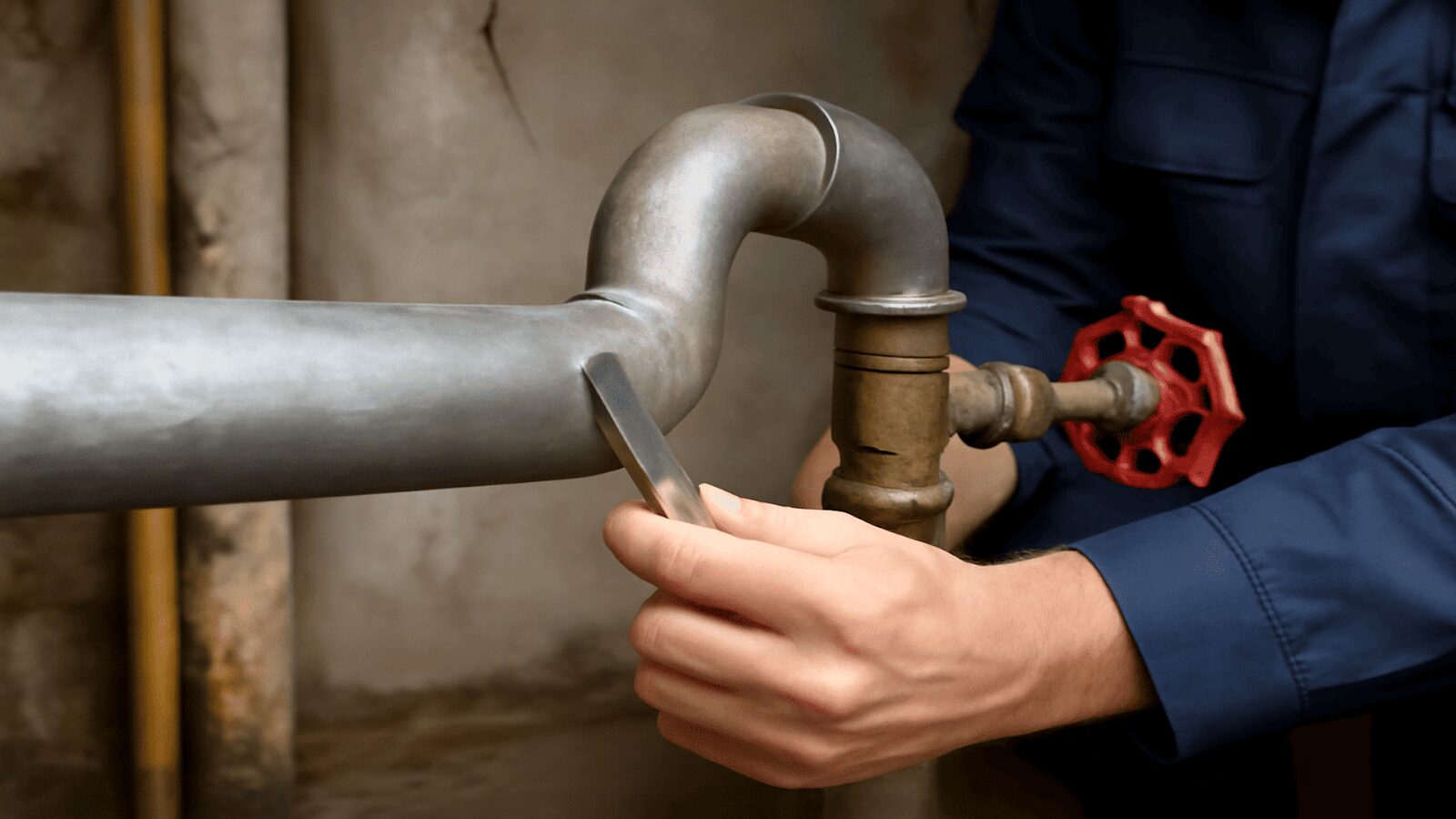You might not be aware that approximately 1% of water service lines in Canada contain lead, which may harm residents’ health. Although lead pipes appear thick and durable, the harm they pose is not visible and can be unbelievably dangerous for your health. Lead is associated with developmental retardation in children and several health issues among adults. There is no safe level of lead intake, even a small unnoticeable is severely harmful.
As professionals at Canadian Rooter, we have assisted thousands of homeowners in the greater Toronto and North Atlanta areas in resolving plumbing problems, especially those associated with the dangerous risks of lead pipes.
In this post, we’re going to answer all of your questions about lead pipe replacement — why it’s so important to get new pipes as soon as possible, how to spot lead pipes, and how to replace them. Keep reading to find out how replacing lead pipes can protect your health and add value to your home.
What Are Lead Pipes and Why Do They Matter?
Lead pipes used to be a staple of homes throughout North America. They were the cheap, durable way to get water from the late 1800s to the mid-1900s. However, the dangers of lead have become increasingly evident over the years. Lead is a neurotoxin that can leak into drinking water as pipes corrode, creating serious health hazards.
Health Risks of Lead
Exposure to lead is dangerous at any age. For children, it can lead to severe developmental delays, lower IQs and learning difficulties. In adults, it may cause high blood pressure, kidney damage and various chronic conditions. Drinking polluted water or using it in cooking provides the greatest danger, but bathing or using it for other purposes can also be hazardous if lead particles are present.
The Dangers of Old Plumbing
Although lead pipes can last up to 100 years, their potential to corrode and leach lead into water makes them unsafe over time. Even if you haven’t already experienced any immediate red flags, you may still be vulnerable.
How to Identify Lead Pipes in Your Home
Don’t know if your home has lead pipes? Begin with your plumbing materials. First and foremost, you need to take a look at what’s been used in your plumbing. Lead pipes still exist in homes built before 1988. Here’s how you can check:
Steps to Identify Lead Pipes
- Locate the service line: The water service line is the pipe that runs underground, connecting your home to the public water main. This line tends to come into your home in the basement or crawl space near the shutoff valve.
- Test the Pipe:
- Scratch Test: Scratch the pipe lightly using a coin. If it’s soft and shining silver, it’s probably made of lead.
- Magnet Test: Lead is most likely the case if a magnet doesn’t stick. Steel and galvanized pipes will pick up a magnet.
Visual Indicators: Lead pipes frequently tend to be smooth, soft, and dull with a grayish colour. If your pipe gives the dazzle and its surface is easily scratched, it may be lead.
Once you realize that the pipes in your home are made of lead, the next step is to replace them as soon as possible.
The Lead Pipe Replacement Process: Step-by-Step
It is necessary to replace lead pipes to maintain the health and safety of your family. At Canadian Rooter, we conduct a process that is elaborate and professional and ensures that the replacement of your lead service lines is done without too much disruption to your property.
Step 1: Inspection and Assessment
Before any replacement work begins, a qualified plumber from Canadian Rooter will thoroughly inspect your plumbing system.
This includes checking:
- The location of your water meter and point of service line entry.
- Whether the service line is made of lead or not can be ascertained.
- Assess whether the entire service line or just a part under your property needs to be replaced.
Step 2: Choosing the Right Replacement Method
Depending on your plumbing system’s design, there are alternative ways of replacing lead pipes:
- Trenchless (No-Dig) Method: This method reduces the disturbance to the lowest level by just pulling the new pipe through the old lead pipe, leaving your yard and landscaping undisturbed.
- Excavation Method: In some cases traditional digging will be required to get rid of the old pipe and to install a new one.
At Canadian Rooter, we can work with you in choosing the best method for your situation, which is cost-effective and minimally invasive.
Step 3: Replacement and Flushing
Flushing is paramount after new pipes are installed. Complete a minimum 30-minute flush of all taps in the home to ensure all lingering lead particles are flushed from your home plumbing system. It recommends that you continue flushing your water periodically for several months once you’ve installed a new lead-filter installation.
Step 4: Post-Installation Testing
It is advisable to have your water tested for lead contamination after the replacement. Canadian Rooter can help to acquire a sample of water to verify the reduced lead levels are below danger levels.
Step 5: Maintenance and Monitoring
Once your pipes are changed, we will help you maintain your new system, such as regular checkups of the system and how to know when there’s an issue.
Why You Should Act Now: Don’t Delay Pipe Replacement
You may ask, “When is the time to replace my lead pipes?” The answer is straightforward—immediately if you know or suspect that your house is connected to lead pipes. The longer you delay, the higher the risks of health and property hazards and expensive repairs in the future.
Benefits of Lead Pipe Replacement
- Improved Health and Safety: The replacement of your lead pipes removes the chance of lead poisoning, particularly for children and pregnant women.
- Increased Water Pressure: Lead pipes are generally of small diameters causing low pressure of water pressure. Replacing them with more modern and spacious pipes enhances the flow and pressure of your water.
- Increased Property Value: A modern plumbing system can add value to your home, especially if you are looking to sell it in the future.
Cost Considerations
Replacing lead pipes can cost different amounts depending on the size of one’s property, the replacement method, and local regulations. Nonetheless, the investment is priceless when you take into consideration the long-term health and property benefits.
Frequently Asked Questions (FAQ)
How worried should I be about lead pipes?
Lead exposure is a serious threat to one’s health, particularly for children who may suffer from developmental delays and other cognitive disorders. Exposure to lead has no safe level; therefore, if you have lead pipes, replacement should be your top priority.
What is the life expectancy of lead pipes?
Lead pipes can last a century but they are dangerous as they contain a dangerous substance. Even though your pipes are intact it is necessary to change them due to health reasons.
Is it safe to drink water from lead pipes?
No, it’s not safe. Lead can seep into your drinking water even low levels of exposure to lead have adverse effects on human health. Never use lead pipes, as they can endanger your health.
Do lead pipes leak?
Of course, pipes made of lead can leak, and their harms include water damage, mould overgrowth and lead exposure. The replacement of leaky lead pipes will be done as soon as possible.
Do lead pipes burst?
Yes, lead pipes leak just like the rest of the pipes from rusting and corrosion over an extensive period that leads to bursting or leaking.
Conclusion: Secure Your Home’s Future Today
Lead pipes are a lurking danger in many old houses. They present health risks, and they can destroy your property. Canadian Rooter specializes in lead pipe replacement with minimal disruption.
Do not delay any longer; update your plumbing system, eliminating lead pipes to secure your system in the long run. Contact us for a free quote, and we will help you make your home a healthier environment for your family.





























